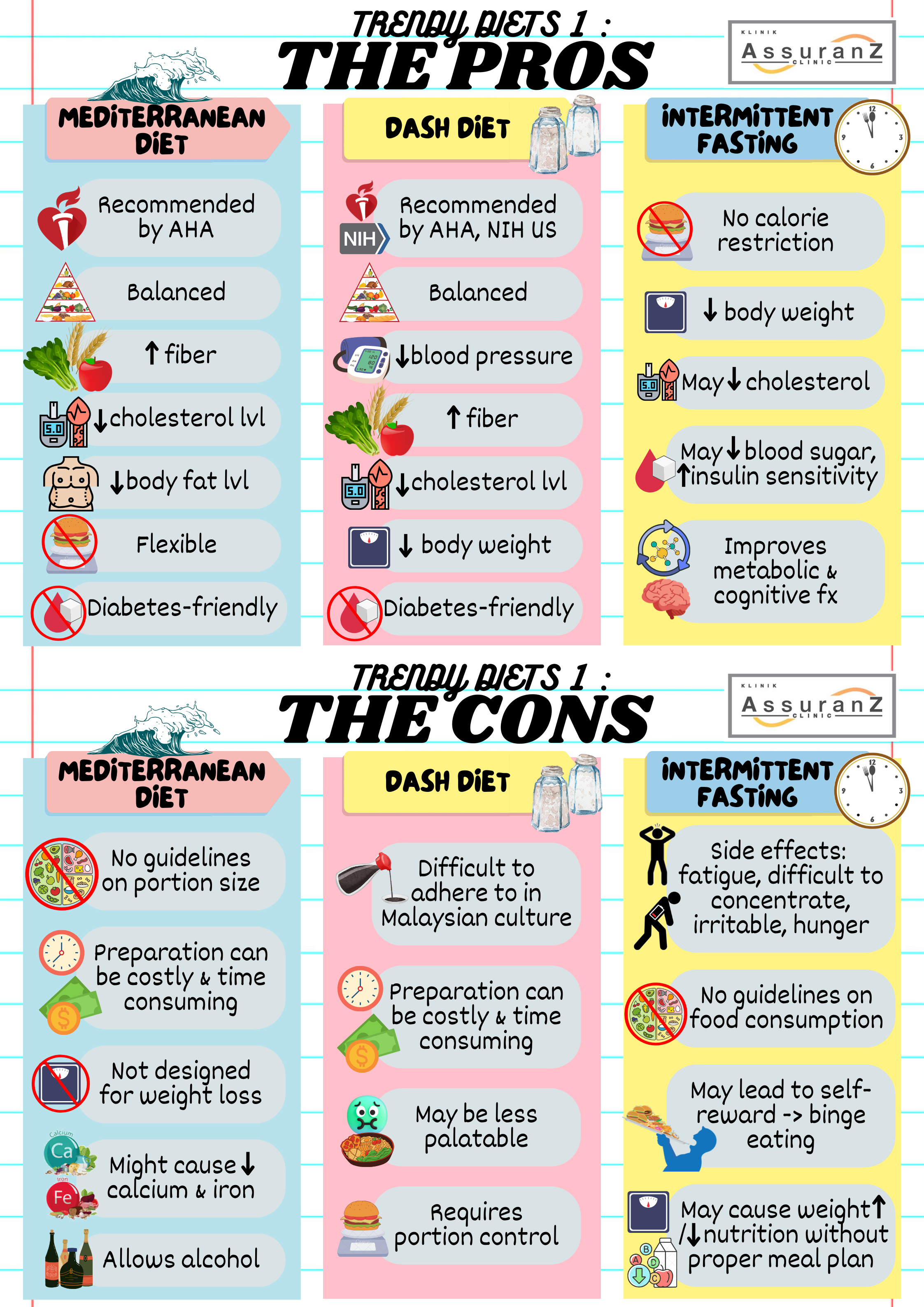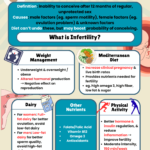Although there is continuous advancement in the medical world, worldwide obesity has been increasing in trend every year and remain as a significant health hazard. Obesity, typically a result of unhealthy lifestyle combined with poor dietary habits, is the contributing factor to numerous chronic diseases including hypertension, diabetes, and heart disease. Today, various dietary modifications have been made by professionals and non-professionals alike to address this issue. However, there are pros and cons to these ‘trendy’ diets, which we will discuss in this article.
尽管医学界不断进步,但全球肥胖症呈逐年增加的趋势,并且仍然是一个重大的健康危害。肥胖通常是不健康的生活方式和不良饮食习惯的结果,是导致高血压、糖尿病和心脏病等多种慢性疾病的因素。如今,专业人士和非专业人士都做出了各种饮食调整来解决这个问题。然而,这些“时尚”饮食有利有弊,我们将在本帖中讨论。
THE MEDITERRANEAN DIET / 地中海饮食
Mediterranean diet (MetDiet) is based on the traditional dietary pattern of people living in the Mediterranean Sea cost. The general features of MetDiet are 1) daily consumption of non-refined carbohydrate sources (such as wholegrain bread, brown rice, wholegrain pasta et cetera) and other food including fresh fruits, vegetables, nuts, seeds, and legumes; 2) olive oil as main source of fat replacing other fats and oils, other healthful fats are highlighted; 3) plenty of fish and other seafood; 4) moderate to low consumption of poultry, eggs and low-fat dairy; 5) monthly red meat consumption and limit sweets; 6) moderate alcohol intake, preferably red wine with meals; and 7) regular physical activity. The MetDiet does not specify the portion size of the food, therefore it depends on the individuals in deciding how much food to consume.
地中海饮食(MetDiet)是以生活在地中海地区的人们的传统饮食模式为基。地中海饮食的一般特征是:
1)每日消耗非精制碳水化合物来源(例如全麦面包、糙米、全麦面食等)和其他食物,包括新鲜水果、蔬菜、坚果、种子和豆类
2)以橄榄油为主要脂肪来源,替代其他油脂,突出其他健康脂肪
3)充足的鱼和其他海鲜
4)适量至低量食用家禽、鸡蛋和低脂乳制品
5)每月红肉消费并限制甜食
6)适量饮酒,进餐时最好是红酒
7) 定期进行身体活动。
地中海饮食没有规定食物的份量,因此取决于个人决定摄入多少食物。
PROS / 优点
- Recommended by the American Heart Association US (AHA).
美国心脏学会(AHA)推荐。
- Balanced, covers all major food groups.
均衡、涵盖所有主要食物类别。
- High anti-inflammatory and antioxidant properties due to high consumption of fibre.
高纤维消耗量,因此具有高抗炎和抗氧化特性。
- A heart healthy diet which is low in saturated and trans-fat, can help in lowering total cholesterol, low density lipoprotein (LDL-C, ‘bad cholesterol’) and triglyceride levels, and increase high density lipoprotein (HDL-C, ‘good cholesterol’).
有助于心脏健康的低饱和脂肪和反式脂肪的健康饮食,可降低总胆固醇、低脂胆固醇(LDL-C,“坏胆固醇”)和三酸甘油酯,增加高脂胆固醇(HDL-C, “好胆固醇”)。
- Supports diabetes management due to high fibre intake and emphasis on non-refined carbohydrate sources.
支持糖尿病管理,基于高纤维的摄入量和重视非精制碳水化合物。
- May help reducing visceral and body fat level.
可能有助于降低内脏脂肪和体脂肪水平。
- Easier to follow as it is flexible.
灵活性,更容易遵循。
CONS / 缺点
- May be costly and time consuming due to preparation of fresh food.
由于需要新鲜食材,导致成本昂贵且准备耗时。
- No specific guidelines for portions of food.
没有针对食物分量的准则。
- Not designed for weight loss, may cause weight gain without proper portion control.
并非专为减肥而设计,如果没有适当控制分量,可能会导致体重增加。
- May not obtain enough calcium and iron due to low consumption of dairy and animal protein.
会因为乳制品和动物蛋白消耗低而无法摄入足够的钙和铁。
- Allows alcohol intake – not recommended for those prone to alcohol abuse, pregnant, at risk of cancer or other medical conditions such as liver disease.
允许喝酒,但不建议那些酗酒、怀孕、患有癌症或其他疾病(如肝病)风险的人。
THE DASH DIET / 得舒饮食
DASH diet stands for Dietary Approaches to Stop Hypertension. It is developed by The National Heart, Lung and Blood Institute (NHLBI) US initially specifically to lower blood pressure. There are no special foods required in this diet. The DASH diet requires individuals to 1) limit sodium intake to between 1500 to 2300 mg/day; 2) consume vegetables, fruits and wholegrains; 3) moderate fat-free or low-fat dairy products, fish, poultry, beans, and nuts; 4) limit high saturated fat food such as fatty meats, full-fat dairy and tropical oils (coconut and palm); and 5) limit sugary beverages and sweets. The recommended serving size depends on the calorie requirement of an individual. The NHLBI provides sample meal plan based on 1600, 2000 and 2600 calories daily.
DASH饮食(得舒饮食)代表控制高血压的饮食方法。它是由美国国家心肺血液研究所(NHLBI)开发,最初专门用于降低血压。这种饮食不需要特殊食物。DASH饮食要求个人:
1) 将钠摄入量限制在1500至2300毫克/天
2)食用蔬菜、水果和全谷物
3)适量的脱脂或低脂乳制品、鱼、家禽、豆类和坚果
4)限制高饱和脂肪食物,如肥肉、全脂乳制品和热带油(椰子和棕榈油)
5)限制含糖饮料和甜食。建议的份量取决于个人的卡路里需求。NHLBI提供基于每日 1600、2000和2600卡路里热量的膳食计划样本。
PROS / 优点
- Recommended by the AHA, NHLBI and National Kidney Foundation.
由美国心脏学会(AHA)、美国国家心肺血液研究所(NHLBI)和国家肾脏基金会推荐。
- Balanced, covers all major food groups.
均衡,涵盖所有主要食物类别。
- High anti-inflammatory and antioxidant properties due to high consumption of fibre.
高纤维消耗量,因此具有高抗炎和抗氧化特性。
- Proven to lower blood pressure through limitation of sodium and increase of potassium intake (which is obtained from plant sources).
事实证明,通过限制钠的摄入量和增加钾的摄入量(从植物中获得)可以降低血压。
- Can help lowering total cholesterol, LDL-C, and triglyceride levels as it is low in saturated and trans-fat.
饱和脂肪和反式脂肪含量低,有助于降低总胆固醇、低脂胆固醇及三酸甘油酯水平。
- Slows progression of heart and kidney disease by blood pressure and cholesterol level control.
通过控制血压和胆固醇水平来减缓心脏疾病和肾脏疾病的进展。
- Supports diabetes management by increasing fibre intake and limiting sugary food and beverages.
通过增加纤维的摄入量及限制含糖食物和饮料,有助于糖尿病管理。
- May help for weight reduction through calorie control according to gender and age as suggested by the NHLBI.
根据美国国家心肺血液研究所(NHLBI)的建议,它可根据性别和年龄控制热量,来减轻体重。
- Flexible and accessible.
灵活且方便。
CONS / 缺点
- Difficult to maintain in Malaysian culture (use of soy sauce, anchovies, palm oil etc in cooking).
在马来西亚文化中难以维持(在烹饪中使用酱油、凤尾鱼、棕榈油等)。
- May be costly and time consuming to prepare fresh food.
在准备新鲜食材中,也许会昂贵和耗时。
- May be less palatable due to reduced salt, sauces, and sodium-containing flavourings in cooking.
味道会欠佳,因为在烹饪时减少盐、酱料和含钠调味料。
- Requires food tracking based on serving size which depends on recommended calorie intake; therefore, some might find it difficult to adhere to.
必须根据份量进行食物追踪,而份量取决于所建议的卡路里摄入量,因此有些人会觉得难以坚持。
INTERMITTENT FASTING / 间歇性禁食
The intermittent fasting (IF) generally involves specific fasting protocols in which individuals periodically abstain from eating for a period of longer than the usual overnight fast. This typically induces energy restriction, but the restriction is not necessarily maintained every day. IF also causes ketosis, a process whereby the body uses fat as main energy source after depletion of carbohydrate storage. While fasting normally refers to complete abstinence from energy consumption, some IF protocols allow small amounts of calorie intake during fasting period. The most known IF protocols can be divided into 3 categories, which are 1) alternate day fasting where individuals alternate between ad libitum feeding days and fasting days, with fasting days normally containing up to around 25% of daily calorie needs; 2) whole-day fasting involving 1 to 2 days of complete fasting day(s) weekly with normal diet on the other days and; 3) time-restricted feeding, whereby individuals follow the same eating routine every day, with a certain number of hours set as fasting window while the remaining hours are the feeding windows (i.e., 16 to 20 fasting hours + 4 to 8 feeding hours). While IF can lead to weight loss, there is no significant evidence on the superiority of IF in terms of weight loss and adherence in comparison to continuous energy restriction.
间歇性禁食(IF)通常涉及特定的禁食方案,其中个人定期禁食的时间比通常的隔夜禁食更长。这通常会导致能量限制,但这种限制不一定每天都维持。间歇性禁食还会导致酮症,这是身体在碳水化合物储存耗尽后使用脂肪作为主要能量来源的过程。虽然禁食通常是指完全戒断能量消耗,但一些禁食方案允许在禁食期间摄入少量卡路里。最著名的间歇性禁食方案可分为3类,即:
1)隔日禁食:个人在随意进食日和禁食日之间交替,禁食日通常包含每日热量需求的 25%左右
2) 全天禁食:包括每周1至2天的完全禁食,其他日子正常饮食
3)限时喂养:即个体每天遵循相同的饮食习惯,设定一定的小时数为禁食窗口,其余时间为喂养窗口(即16至20小时禁食+4至8小时喂养)。
虽然间歇性禁食可以导致体重减轻,但没有证据表明间歇性禁食在减肥和坚持方面比持续能量限制具有优越性。
PROS / 优点
- No calorie counting and macronutrients restriction, thus may be easier to adhere to.
没有卡路里的计算和宏亮营养素的限制,更容易坚持。
- Supports weight and body fat loss due to subsequent reduction of calorie intake through restriction of eating window.
通过限制饮食空窗期,减少热量摄入,有助于减轻体重和体脂。
- Potentially beneficial in reducing total cholesterol, LDL-C, triglyceride, blood sugar levels, and increasing insulin sensitivity and HDL-C level following energy deficit and weight loss.
有益于降低总胆固醇、低脂胆固醇(LDL-C)、三酸甘油酯、血糖水平,并在能量不足和体重减轻后,提高胰岛素敏感性和高脂胆固醇(HDL-C)水平。
- Can improve metabolic function through better regulation of circadian rhythm (body clock).
通过更好地调节昼夜节律(生物钟)来改善代谢功能。
- Might improve cognitive function by reducing inflammation and enhancing antioxidant mechanism.
通过减少炎症和增强抗氧化机制来改善认知功能。
CONS / 缺点
- Side effects on fasting days include hunger, irritability, fatigue, difficulty concentrating, and increased thought about food.
禁食日的副作用包括饥饿、烦躁、疲劳、难以集中注意力和对食物的渴望。
- No specific guidelines on food consumption including calorie, added sugar, trans-fat etc, therefore unhealthy food such as processed meat and fast food may be included.
没有关于食物消费,包括卡路里、添加糖、反式脂肪等的具体指南,因此可能会包括加工肉类和快餐等不健康食品。
- Can cause weight gain or difficulty to lose weight with reduced physical activity due to fatigue and if fasting is not accompanied with healthy eating.
由于疲劳及没有健康饮食的禁食,会减少体力活动,从而导致体重增加或者减肥困难。
- May cause unhealthy eating habits on non-fasting days/window, such as binge eating as self-reward.
会造成非禁食日或空窗期的不健康饮食习惯,例如以暴饮暴食来奖励自己。
- May cause malnutrition without proper meal planning.
会造成没有适当的膳食计划的营养不良。
- Not suitable for people with certain conditions such as diabetes, kidney disease and pregnancy.
不适合那些患有糖尿病、肾脏疾病和怀孕的人。






